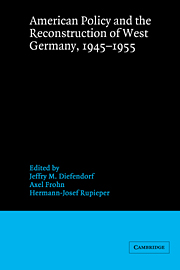Book contents
- Frontmatter
- 1 “Ripping Holes in the Iron Curtain”: The Council on Foreign Relations and Germany, 1945–1950
- 2 U.S. Policy on a West German Constitution, 1947-1949
- 3 American Policy toward German Unification, 1949-1955
- 4 Marshall Plan and Currency Reform
- 5 American Policy toward Germany and the Integration of Europe, 1945-1955
- 6 From Morgenthau Plan to Schuman Plan: America and the Organization of Europe
- 7 Return to Normality: The United States and Ruhr Industry, 1949-1955
- 8 West German Agriculture and the European Recovery Program, 1948-1952
- 9 Science, Technology, and Reparations in Postwar Germany
- 10 American Deconcentration Policy in the Ruhr Coal Industry
- 11 Technology Transfer and the Emergence of the West German Petrochemical Industry, 1945-1955
- 12 The Free University of Berlin: A German Experiment in Higher Education, 1948–1961
- 13 HICOG and the Unions in West Germany: A Study of HICOG’s Labor Policy toward the Deutscher Gewerkschaftsbund, 1949–1952
- 14 U.S. Military Occupation, Grass Roots Democracy, and Local German Government
- 15 German Democratization as Conservative Restabilization: The Impact of American Policy
- 16 America and the Rebuilding of Urban Germany
- 17 U.S. Policy toward German Veterans, 1945-1950
- 18 Grand Illusions: The United States, the Federal Republic of Germany, and the European Defense Community, 1950-1954
- 19 The Federal Republic of Germany as a “Battlefield” in American Nuclear Strategy, 1953-19
- 20 The Presence of American Troops in Germany and German-American Relations, 1949-1956
- 21 John J. McCloy and the Landsberg Cases
- 22 Sources in German Archives on the History of American Policy toward Germany, 1945-1955
- 23 U.S. High Commissioner for Germany and Related Records: Sources for the History of the Federal Republic of Germany, 1949–1955, in the U.S. National Archives and Records Administration
- Bibliography
- Index
10 - American Deconcentration Policy in the Ruhr Coal Industry
Published online by Cambridge University Press: 05 January 2013
- Frontmatter
- 1 “Ripping Holes in the Iron Curtain”: The Council on Foreign Relations and Germany, 1945–1950
- 2 U.S. Policy on a West German Constitution, 1947-1949
- 3 American Policy toward German Unification, 1949-1955
- 4 Marshall Plan and Currency Reform
- 5 American Policy toward Germany and the Integration of Europe, 1945-1955
- 6 From Morgenthau Plan to Schuman Plan: America and the Organization of Europe
- 7 Return to Normality: The United States and Ruhr Industry, 1949-1955
- 8 West German Agriculture and the European Recovery Program, 1948-1952
- 9 Science, Technology, and Reparations in Postwar Germany
- 10 American Deconcentration Policy in the Ruhr Coal Industry
- 11 Technology Transfer and the Emergence of the West German Petrochemical Industry, 1945-1955
- 12 The Free University of Berlin: A German Experiment in Higher Education, 1948–1961
- 13 HICOG and the Unions in West Germany: A Study of HICOG’s Labor Policy toward the Deutscher Gewerkschaftsbund, 1949–1952
- 14 U.S. Military Occupation, Grass Roots Democracy, and Local German Government
- 15 German Democratization as Conservative Restabilization: The Impact of American Policy
- 16 America and the Rebuilding of Urban Germany
- 17 U.S. Policy toward German Veterans, 1945-1950
- 18 Grand Illusions: The United States, the Federal Republic of Germany, and the European Defense Community, 1950-1954
- 19 The Federal Republic of Germany as a “Battlefield” in American Nuclear Strategy, 1953-19
- 20 The Presence of American Troops in Germany and German-American Relations, 1949-1956
- 21 John J. McCloy and the Landsberg Cases
- 22 Sources in German Archives on the History of American Policy toward Germany, 1945-1955
- 23 U.S. High Commissioner for Germany and Related Records: Sources for the History of the Federal Republic of Germany, 1949–1955, in the U.S. National Archives and Records Administration
- Bibliography
- Index
Summary
After the Second World War, the coal, iron, and steel industries indisputably represented the leading sectors of the German economy. Coal was the most important source of energy for steel making as well as for generation of electricity; iron and steel were the decisive basic ingredients not only of war production but also of peace time economy.
The heavy industries of the Ruhr were highly concentrated and cartelized. Beginning at the turn of the century, this trend had increased during the Weimar Republic and had reached it speak under National Socialism. In particular, coal and steel had been strongly integrated into the so-called Verbundwirtschaft. The motive for this process was the desire of the combines to secure the source of basic production inputs, raw materials and energy. In 1945, 55 percent of coal mining was combined with the iron industry technically, economically, and now by ownership: technically through the exchange of fuels and energy, economically through the harmonization of investments and of profits and losses, organically through the combination of mines and iron factories into integrated business concerns. The Verbundwirtschaft represented a vertical organization structure of the production from the raw material to the finished product. This connection was especially marked in the concern of the Vereinigte Stahlwerke (United Steel Works). Founded in 1926, this company, through its subsidiary Gelsenkirchener Bergwerks-A.G., extracted 19 percent of the total hard coal output, which amounted to about 35 percent of Verbundkohle (bound coal).
- Type
- Chapter
- Information
- Publisher: Cambridge University PressPrint publication year: 1994
- 2
- Cited by



